The article presents the content and analyzes the story of Leo Tolstoy "Fire Dogs".
Brief biography of the author
L. N. Tolstoy was born back in 1828. His parents belonged to a noble family, owned the estate "Yasnaya Polyana" in the Tula region (then - the province). They died early, leaving their son in the care of relatives.
The guardians took good care of the boy, gave him an excellent education. After graduating from Kazan University, Lev joined the army and left for the Caucasus. It was here that he began to write. His first work is "Childhood". In total, Tolstoy wrote more than 170 books.
Russian author Leo Tolstoy is known to almost every compatriot for such works as "Anna Karenina" or "War and Peace". But he also wrote a lot for children (the writer himself had 13 offspring, 5 of them died in infancy). Tolstoy's most famous children's stories:
- "Philip".
- "Three Bears".
- "Bone".
- "Kitty".
- "Fire".
- "Lion and dog"
- "The truth is more precious than anything."
The children's story "Fire Dogs" is interesting and instructive. The analysis of the work is given in the article.
Leo Tolstoy died in 1910, but his memory and love for his work will always live on.

The story "Fire Dogs" begins with the explanation that during a fire, small children get scared, hide and sit quietly. In smoke and soot, rescuers cannot always see them; they do not respond to calls. What to do, how to save kids from fire? In London, especially for such purposes, they began to train dogs that, with the help of scent, found children and carried them out of the fire. Four-legged friends were called that - fire dogs. One heroic dog named Bob carried 12 children out of the fire.
The story goes on to tell how one day Bob carried a 2-year-old girl out of the house during a fire. The firemen, making sure that the dog was safe, wanted to take her away, because the girl's mother said that there were no more children in the house, but Bob was eager for the fire. He was released, and he fearlessly ran into the burning house, and a minute later he returned back, carrying something in his teeth. Is it still a child? When the dog ran closer, everyone saw that she had saved a big doll from the fire! The firemen laughed.
Analysis of the work

Analyzing the story "Fire Dogs" (Tolstoy is the author of this work), it is necessary to point out the courage of the dog, his quick wits and dedication while saving children from the fire. With this example, the author wants to show how closely connected the world of people and animals is, trying to inspire the reader with the idea that in difficult times our smaller brothers are able to save them from trouble, so you need to take care of them and protect them. Much later, another hero, the Little Prince, will say: "We are responsible for those we have tamed." The firefighters in the children's book did exactly that: they carefully examined Bob after he ran out of the burning house to make sure that the dog was safe and sound. Such care for a valiant four-legged friend is worthy of respect.
Approximate on the topic: "Fire dogs" (Tolstoy L. N.)

This lesson is held in 3-4 grade. Its tasks include the following:
- to introduce students to the author L. N. Tolstoy, his works;
- practice reading skills;
- develop memory, attention, the ability to listen to others, as well as to formulate and express their point of view;
- to expand students' knowledge about the relationship between nature and man;
- Teach children to respect and appreciate animals.
Indicative action plan:
- Tell the students who Leo Tolstoy is, briefly and in an accessible language describe his life, characterize his work, name the most popular works, recommend reading children's stories (give a list). For clarity, use the presentation.
- Read the story "Fire Dogs" (Tolstoy), an analysis of which will be done later.
- Answer the teacher's questions: "Who is the story about?" (about the fire dog), "What was the dog's name?" (Bob) "What do small children do during a fire?" (they hide and remain silent), "Where did they first start training dogs in fire fighting?" (in London), "Why did Bob the dog go back to the burning house?" (behind the doll). Such short questions and answers will help students remember the story better.
- Go directly to the analysis of the work. The teacher gives leading questions: “What impression did this short story make on you?”, “How did the firefighters treat Bob the dog?”, “How does this dog make you feel?”, “Would you like to have such a four-legged person next to you friend?", "What are the obligations of the owner in relation to his dog, to other pets?" The answers to these questions should not be short, but voluminous, based on the student's reflections.
To consolidate the material, you can invite the children to draw a drawing for Tolstoy's story "Fire Dogs" at home and bring it to the classroom so that the teacher can organize a mini-exhibition of creative works.




